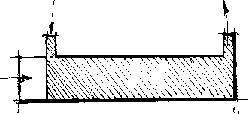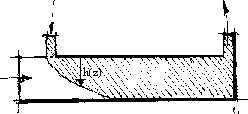|
rFcTo |
|
rFcTf |
|
Po |
 |
|
|
|
|
|
|
rFcTo |
|
rFcTf |
|
Po |
 |
|
|
|
|
|
The form of the local energy conservation equation which governs the microwave water heating process during stady state conditions can be written as :
where P(z) and T(z) are the microwave power and the temperature of water at a distance z away from the inlet, r, F, and c are the volumetric mass, flow rate and specific heat of water respectively.
However the microwave power at a distance z away from the inlet is given by, [4], [7] :
where Po and a(z') are the input microwave power and the heat transfert absorption coefficient respectively. For a WR 340 water heat transfer for which e is the thickness of the liquid slab a(z') = ß / T(z') in the temperature range 25 < T < 75° C where ß is the following physical constant :
Integrating eqn.(1) gives :
where Po is totally absorbed along the heat transfer, To and Tf are the input and output temperatures of water respectively.
Differentiating eqn.(2) gives :
Substracting eqn.(4) from eqn.(1) yields :
However eqn.(3) gives :
Substituing P(z) / T(z), eq.(5) yields :
Integrating eqn.(7) along the heat transfer gives :
where DT = Tf - To and
d = {T(z) - To}/DT = DT(z)/DT
DT is related to the
process parameters by the formula : DT = Po / rFc
Ignoring the absorption coefficient variation with a(z') = ß / To gives the simplified equation :
where z* is the approximate position at ratio d.
Now let us consider a volume of water of thickness e and height h(z) described as follows :

This design is well adapted to minimize microwave reflections on the inner pipe. The corresponding heat transfer absorption coefficient a'(z') can be written as:
where b is the height of the wave guide.
By following the same procedure as for the rectangular slab, eqn.(7) becomes :
Integrating eqn.(11) along the heat transfer gives :
where V(z) is the necessary volume of water which leads to the required ratio d.
Therefore :
By definition v is the volume of a rectangular liquid slab of eight b at a point distance To/2ß away from the inlet :
As the thickness e is substantially smaller than the width of the heat transfer, ß varies linearly with e [7], therefore v as well as V(z) at a given ratio d do not depend upon the shape h(z) of the inner pipe.
It will be noted that the volume V(z) is the appropriate parameter for describing the microwave heating process.
At Our store, we pride ourselves on offering high-quality vape products, particularly the iget vape Australia Premium Devices, known for their Smooth Performance and reliability. if you encounter issues with your device, learning how to fix iget bar is essential. Start by checking the battery connection, ensuring it’s charged and properly seated. Clean the contacts to remove any debris, and if the problem persists, consider replacing the coil or contacting customer support for further assistance.